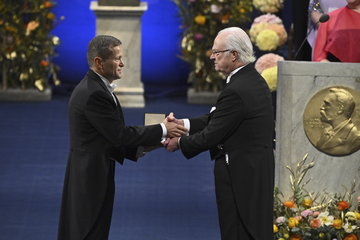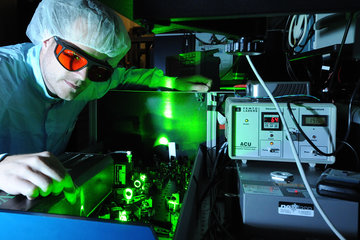When the laws of physics are at stake
Quantum electrodynamics put to the test
The magnetic properties of a free electron charge are very well understood and agree perfectly with the expectations of quantum mechanics. Whether these laws of quantum mechanics also apply to electrons bound to atomic nuclei was still a mystery until now. This is because strong electric fields prevail in the vicinity of a heavy atomic nucleus - extreme conditions that have now been artificially induced in the laboratory.

Quantum electrodynamics, a school of quantum mechanics, is the best-tested theory in physics. It describes all electrical and magnetic interactions of light and matter. In the macroscopic world, magnets can be created by allowing electric currents to flow in a circle. A similar effect occurs in the quantum world. Here, atoms have magnetic properties because charged elementary particles constantly swarm around atoms, and a single electron also possesses a so-called magnetic moment due to its own spin. This magnetic property can be measured very well for free electrons and corresponds to the expectations of quantum electrodynamics. Here, measurement and theory agree to within ten decimal places. A research team at the Max Planck Institute for Nuclear Physics in Heidelberg has now confirmed with precision measurements that the predictions of quantum electrodynamics also apply where electrons are exposed to strong electric fields, namely inside heavy atoms, in the immediate vicinity of the atomic nucleus. For this purpose, the researchers measured the magnetic properties of individual electrons in tin atoms in an experiment called Alphatrap.
To investigate how individual electrons behave in the strong electric fields of the tin atomic nuclei, the team first had to strongly ionise the tin atoms. Ions are atoms that lack electrons in this case and thus have a net positive charge. The atomic nucleus of tin contains 50 protons, so this element normally also has 50 electrons in its shell to be electrically neutral. "So we first had to remove 49 electrons," says Jonathan Morgner, a PhD student in Professor Klaus Blaum's research group. The result is so-called hydrogen-like tin, i.e. tin ions that - similar to hydrogen - contain only one electron in the atomic shell. This was possible with the help of the Heidelberg-Ebit, in which a cloud of around 100,000 tin ions is bombarded with high-energy electrons. In the process, the ions gradually lose their bound of electrons. Afterwards the ions that have only one electron left in their shells are filtered and fed into the particle trap of the Alphatrap experiment. "Thanks to the long storage time of several months, we were able to measure the magnetic moment, i.e. the magnetic properties of the electrons in the ions, with unprecedented accuracy."

Alphatrap is a high-precision experiment whose heart is a Penning trap, in which charged particles are held in place with electromagnetic fields. A vacuum at very low temperatures inside the trap prevents the strongly positively charged tin ions from cannibalising foreign atoms, snatching electrons from them and refilling their electron shells.
The researchers were then able to measure the so-called g factor of the electron on the captured tin ions using irradiated microwaves. At the matching frequency, the electrons in the applied magnetic field in the trap make so-called spin flips - i.e. a reorientation of their "magnetic needle". This effect allows highly accurate measurements of the g factor, also called gyromagnetic factor. This is a measure of how strong the magnetic field of the electron is.
The dimensionless value of the g factor is about 2. The exact value can be predicted by quantum electrodynamics, and depends on the environment of the electron. And this is where the highly charged tin ions come into play. Since they have only one electron, they can be described in theory similarly to a hydrogen atom. This simplifies the calculations enormously. However, due to the high charge of the tin nucleus, extremely high electric fields of around 1015 volts per centimetre are present on the position of the electron around the atomic nucleus. These field strengths are orders of magnitude stronger than what can be realized today even with the most powerful laser systems in any experiments. Thus, such atomic nuclei are ideally suited to test the predictions of quantum electrodynamics especially in the high-field regime, i.e., under extreme conditions.
The complicated calculations of the theoretical value of the g factor at strong fields provide somewhat less precise predictions than for the free electron, due to the additional interaction with the nucleus. The theoretical calculations predict a value of 1.910 561 821 (299), with the decimal places in the parentheses indicating the uncertainties. The value measured in the Alphatrap experiment is much more accurate with 1.910 562 059 (1). "The two values are in very good agreement, so this is an excellent confirmation of quantum electrodynamics," Morgner said. "This shows that our previous understanding of physics works even at such extreme fields." Until now, comparable measurements of the g-factor of electrons had only been carried out for much lighter elements such as silicon.
Thanks to the successful measurements, the researchers are already thinking about using even heavier ions. Hydrogen-like lead or uranium have a much higher electric field than tin. The Heidelberg facility is therefore already being modernised to enable further and even stronger fundamental tests of quantum electrodynamics.
Dirk Eidemüller / Tobias Beuchert (MPG Editorial Team)











